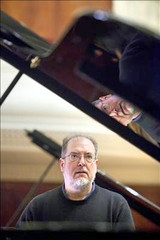|
Back
Two Monuments From White Plains New York
Isaac Stern Auditorium, Carnegie Hall
02/09/2014 -
Ludwig van Beethoven: Piano Sonata No. 30 in E Major, Opus 109
Franz Schubert: Fantasy in C Major (“Wanderer”), D. 760
Charles Tomlinson Griffes: Roman Sketches: “The Fountain of Acqua Paola” & “The White Peacock” – Fantasy Pieces: Scherzo
Fryderyk Chopin: Piano Sonata No. 3 in B Minor, Opus 58
Garrick Ohlsson (Pianist) 
G. Ohlsson(© Wojciech Grzedzinski)
Were I appointed King of White Plains, 50 miles north of New York, I would erect two towering statues in the center of that town, to their two most eminent artists. One would be the great pianist Garrick Ohlsson, the other would be the great composer, Charles Tomlinson Griffes. Even without a public sculpture, yesterday afternoon’s recital was a rare monument to them both.
And for the moment, that recital will have to suffice.
Griffes is not as well known as he should be, for reasons listed below. Garrick Ohlsson, now 65, with a height one inch less, 6”4”, with the hands of a Rachmaninoff, has been literally a towering pianist and certainly well known since the age of 18, when he garnered First Prize at the Busoni Competition in Italy. After First Prize at the International Montreal Competition, and the first (and still only) American to win the International Fryderyk Chopin Piano Competition, Mr. Ohlsson has towered above nearly all American pianists. Not only Chopin, but in virtually all composers of the 19th and 20th Centuries.
His integrity, his unassailable technique, his seriousness, and, most of all, by a fullness, offer a depth in everything which he performs. Yesterday afternoon, his choices were as soaring as he was. Yet Mr. Ohlsson was born to make them exhilarating. That last word is essential. Mr. Ohlsson is not an “intellectual” pianist, he is neither a Brendel nor a Perahia. At the same time, he never plays down to his audience. He never offers technique for the sake of technique, he doesn’t hold a fermata more than necessary (well, actually he did in the encore Chopin waltzes, where it was permitted). And he certainly doesn’t play to show how well he plays.
And yet Mr. Ohlsson is never afraid to make the most personal statements. In the opening Beethoven Sonata, Opus 109, the first movement, that paean to utter placidity, was played as if improvising, with a freedom that gave the illusion he was composing as he went along. The second movement Prestissimo was given all the whirlwind improvisatory feeling it deserved. But of course it was those transcendental variations in the Finale that are the signature of any great pianist.
Beethoven commanded this to be “songlike with the greatest inwardness of feeling”, and Mr. Ohlsson started that way. Yet each of the six variations plunged deeper and deeper into more chaos, more whirling madness, and finally home again, to the original song. Mr. Ohlsson played it slower than before, but again with a placidity which was reminiscent of the opening movement.
Beethoven was fascinated by the early German translations from the Buddhist sutras, and I had the feeling with Mr. Ohlsson that after the music dug down to earthly human things, Beethoven ended with the Absolute Void, the Nothingness of Buddhist thought. That, admittedly, is a fatuous thought. But why not?
The Schubert “Wanderer” was pure emotion, pure thrill, fire and ice, dazzling arpeggios, a very feeling adagio, and a fugue that, like the Beethoven variations was as much architecture as music.
Those who know Mr. Ohlsson’s work know that his Chopin is beyond words. He is at the time of his performing skills here, and the B Minor Sonata was, even in the most galvanizing sessions, lyrical. This was the Chopin who was jealous of Bellini, the Chopin who, even at his most dramatic, could never be less than beautiful.
He took liberties with the Chopin waltz encores. But he did not, as Marc-André Hamelin does, parody Chopin. He exaggerated rhythms and meters, he was a bit showy. But these encores were the chocolate candies which finished a serious meal.
I was especially interested, though, in the three rare works, by Charles Griffes. Griffes died about the same age as Mozart, 35, of Spanish flu. And outside of study in Europe, the White Plains-born composer spent all his life just a few miles from White Plains teaching in a Tarrytown boys’s school. But Griffes was no recluse, and his music was very popular in its day.
Griffes is known today as an impressionist, a Debussyan, and the three works played yesterday had all the pictorialism of a Debussy prelude. His White Peacock was almost literally physical, with the tail waving in a flurry of 64th notes, the color rising and falling. The The Fountain of Acqua Paola could have come from Respighi, limpid, undulating.
Yet, though Mr. Ohlsson played the work of his White Plains paisano, born 130 years ago, with the most lavish understanding and beauty. Griffes obviously had a long way to go before he would compete with Debussy. The lines were too apparent, they were lovely but they didn’t take side-trips to Debussy’s unknown shadows and nuances.
Which is why the Scherzo was so interesting No images here in the title, but it was obvious that Griffes was working with American Indian motifs, the minor fifths an ersatz exotica, yet certainly American. Busoni had done the same thing with Native American themes, but one has the feeling that Charles Griffes, had he lived but ten years longer, might have expanded his music into a totally original and glorious style.
That, though, is the same kind of unknowable hypothesis we have with Mozart and Schubert, and we can only fantasize. With Garrick Ohlsson, we need no fantasies in our mind, for his arresting performances on the stage of Carnegie Hall were gloriously real.
Harry Rolnick
|